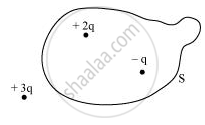Advertisements
Advertisements
प्रश्न
A hollow sphere of radius R has a point charge Q at its centre. Electric flux emanating from it is `phi`. If both the charge and the radius of the sphere are doubled, electric flux emanating from the sphere will ______.
पर्याय
remain the same
become `2phi`
become `4phi`
become `8phi`
उत्तर
A hollow sphere of radius R has a point charge Q at its centre. Electric flux emanating from it is `phi`. If both the charge and the radius of the sphere are doubled, electric flux emanating from the sphere will `bbunderline(become 2phi)`.
Explanation:
Since total electric flux passing through the spherical surface due to point charge Q at centre is
`phi = "q"/epsilon_0` where q = charge
If q' = 2q then
`phi"'" = "2q"/epsilon_0 = 2phi`
APPEARS IN
संबंधित प्रश्न
Write its (electric flux.) S.I unit.
What is the electric flux through a cube of side 1 cm which encloses an electric dipole?
Careful measurement of the electric field at the surface of a black box indicates that the net outward flux through the surface of the box is 8.0 × 103 N m2/C.
- What is the net charge inside the box?
- If the net outward flux through the surface of the box were zero, could you conclude that there were no charges inside the box? Why or Why not?
A uniformly charged conducting sphere of 2.4 m diameter has a surface charge density of 80.0 μC/m2.
- Find the charge on the sphere.
- What is the total electric flux leaving the surface of the sphere?
Two charges of magnitudes +4Q and − Q are located at points (a, 0) and (− 3a, 0) respectively. What is the electric flux due to these charges through a sphere of radius ‘2a’ with its centre at the origin?
Figure shows three point charges +2q, −q and + 3q. Two charges + 2q and −q are enclosed within a surface ‘S’. What is the electric flux due to this configuration through the surface ‘S’?

Mark the correct options:
The electric field intensity due to an infinite cylinder of radius R and having charge q per unit length at a distance rir r(r > R) from its axis is ______.
